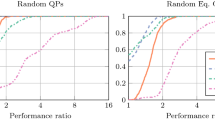Abstract
We present an implementation of the LP Dual Active Set Algorithm (LP DASA) based on a quadratic proximal approximation, a strategy for dropping inactive equations from the constraints, and recently developed algorithms for updating a sparse Cholesky factorization after a low-rank change. Although our main focus is linear programming, the first and second-order proximal techniques that we develop are applicable to general concave–convex Lagrangians and to linear equality and inequality constraints. We use Netlib LP test problems to compare our proximal implementation of LP DASA to Simplex and Barrier algorithms as implemented in CPLEX.
Similar content being viewed by others
References
Andersen E.D., Andersen K.D. (1995) Presolving in linear programming. Math. Program. 71, 221–245
Bergounioux M., Kunisch K. (2002) Primal-dual strategy for state-constrained optimal control problem. Comput. Optim. Appl. 22, 193–224
Bixby R.E. (1994) Progress in linear programming. ORSA J. Comput. 6, 15–22
Björck A., Elfving T. (1979) Accelerated projection methods for computing pseudoinverse solutions of systems of linear equations. BIT 19, 145–163
Clarke F.H. (1975) Generalized gradients and applications. Trans. Am. Math. Soc. 205, 247–262
Davis T.A. (2005) Algorithm 849: a concise sparse Cholesky factorization package. ACM Trans. Math. Softw. 31, 587–591
Davis T.A., Gilbert J.R., Larimore S.I., Ng E.G. (2004) Algorithm 836: COLAMD, a column approximate minimum degree ordering algorithm. ACM Trans. Math. Softw. 30, 377–380
Davis T.A., Gilbert J.R., Larimore S.I., Ng E.G. (2004) A column approximate minimum degree ordering algorithm. ACM Trans. Math. Softw. 30, 353–376
Davis T.A., Hager W.W. (1999) Modifying a sparse Cholesky factorization. SIAM J. Matrix Anal. Appl. 20, 606–627
Davis T.A., Hager W.W. (2001) Multiple-rank modifications of a sparse Cholesky factorization. SIAM J. Matrix Anal. Appl. 22, 997–1013
Davis T.A., Hager W.W. Dual multilevel optimization, to appear in Mathematical Programming University of Florida (2004)
Davis T.A., Hager W.W. (2005) Row modifications of a sparse Cholesky factorization. SIAM J. Matrix Anal. Appl. 26, 621–639
Davis, T.A., Hager, W.W., Chen, Y.C., Rajamanickam, S. CHOLMOD: a sparse Cholesky factorization and modification package, ACM Trans. Math. Softw. (2006) (in preparation)
Dongarra J.J., Du Croz J.J., Duff I.S., Hammarling S. (1990) A set of level 3 basic linear algebra subprograms. ACM Trans. Math. Softw. 16, 1–17
Ekeland, I., Temam, R. Convex Analysis and Variational Problems. North-Holland, Amsterdam (1976)
Gill P.E., Saunders M.A., Shinnerl J.R. (1996) On the stability of cholesky factorization for quasi-definite systems. SIAM J. Matrix Anal. Appl. 17, 35–46
Golub G.H., Loan C.F.V. (1979) Unsymmetric positive definite linear systems. Linear Algebra Appl. 28, 85–98
Hager W.W. (1979) Convex control and dual approximations, part I. Control Cybern. 8, 5–22
Hager, W.W. Inequalities and approximation. In: Coffman, C.V., Fix, G.J. (eds.) Constructive Approaches to Mathematical Models pp. 189–202. (1979)
Hager, W.W. The dual active set algorithm. In: Pardalos, P.M. (ed.) Advances in Optimization and Parallel Computing pp. 137–142. North Holland, Amsterdam (1992)
Hager W.W. (1998). The LP dual active set algorithm. In: Leone R.D., Murli A., Pardalos P.M., Toraldo G. (eds). High Performance Algorithms and Software in Nonlinear Optimization. Kluwer, Dordrecht, pp. 243–254
Hager W.W. (2000) Iterative methods for nearly singular linear systems. SIAM J. Sci. Comput. 22, 747–766
Hager W.W. (2002) The dual active set algorithm and its application to linear programming. Comput. Optim. Appl. 21, 263–275
Hager, W.W. The dual active set algorithm and the iterative solution of linear programs. In: Pardalos, P.M., Wolkowicz, H. (eds.) Novel Approaches to Hard Discrete Optimization, vol. 37, pp. 95–107 Fields Institute Communications, (2003)
Hager W.W., Hearn D.W. (1993) Application of the dual active set algorithm to quadratic network optimization. Comput. Optim. Appl. 1, 349–373
Hager W.W., Ianculescu G. (1984) Dual approximations in optimal control. SIAM J. Control Optim. 22, 423–465
Hager, W.W., Shi, C.-L., Lundin, E.O. Active set strategies in the LP dual active set algorithm, tech. report. University of Florida, http://www.math.ufl.edu/~hager/LPDASA (1996)
Karypis G., Kumar V. (1998) A fast and high quality multilevel scheme for partitioning irregular graphs. SIAM J. Sci. Comput. 20, 359–392
Karypis G., Kumar V. (1999) Multilevel k-way partitioning scheme for irregular graphs. J. Parallel Distrib. Comput. 48, 96–129
Karypis G., Kumar V. (1999) Parallel multilevel k-way partitioning scheme for irregular graphs. SIAM Rev. 41, 278–300
Liu J.W.H. (1991) A generalized envelope method for sparse factorization by rows. ACM Trans. Math. Softw. 17, 112–129
Martinet B. (1970) Régularisation d’inéquations variationnelles par approximations successives. Rev. Francaise Inform. Rech. Oper. Ser. R-3 4, 154–158
Martinet B. (1972) Determination approachée d’un point fixe d’une application pseudo-contractante. Comptes Rendus des Séances de l’Académie des Sciences 274, 163–165
Ng E.G., Peyton B.W. (1993) Block sparse Cholesky algorithms on advanced uniprocessor computers. SIAM J. Sci. Comput. 14, 1034–1056
Pan P.Q. (2004) A dual projective pivot algorithm for linear programming. Comput. Optim. Appl. 29, 333–346
Rockafellar R.T. (1976) Monotone operators and the proximal point algorithm. SIAM J. Control 14, 877–898
Roos C., Terlaky T., Vial J.-P. (1997) Theory and Algorithms for Linear Optimization: An Interior Point Approach. Wiley, New York
Saunders M.A. (1996). Cholesky-based methods for sparse least squares: The benefits of regularization. In: Adams L., Nazareth J.L. (eds). Linear and Nonlinear Conjugate Gradient-Related Methods. SIAM, Philadelpha, pp. 92–100
Shih, C.L. Active Set Strategies in Optimization. PhD Thesis, University of Florida, Department of Mathematics (1995)
Vanderbei R.J. (1995) Symmetric quasi-definite matrices. SIAM J. Optim. 5, 100–113
Volkwein S. (2003) Lagrange-SQP techniques for the control constrained optimal boundary control for Burger’s equation. Comput. Optim. Appl. 26, 253–284
Author information
Authors and Affiliations
Corresponding author
Additional information
This material is based upon work supported by the National Science Foundation under Grant No. 0203270.
Rights and permissions
About this article
Cite this article
Davis, T.A., Hager, W.W. A sparse proximal implementation of the LP dual active set algorithm. Math. Program. 112, 275–301 (2008). https://doi.org/10.1007/s10107-006-0017-0
Received:
Accepted:
Published:
Issue Date:
DOI: https://doi.org/10.1007/s10107-006-0017-0
Keywords
- Dual active set algorithm
- Linear programming
- Simplex method
- Barrier method
- Interior point method
- Equation dropping




